Most easy recipes are not easy. Achieving simplicity is never actually that simple, but in the kitchen it is usually also contingent on a well-trained hand and a very well-stocked pantry. This makes the genuinely easy three-ingredient recipe a holy grail of sorts.
Here, then, the mother lode: 50 three-ingredient beauties. Some are meals in themselves. Some are a good base to build upon. Others still are a sweet something for afters. They run the gamut from “blink and it’s ready” to a long, slow cook, but none will break the bank. Crucially, all use only three things other than oil, butter, salt, pepper and water. As simple as ready, steady … cook!
Green frittata

Jacob Kenedy, Bocca di Lupo
Roughly chop some green veg (spinach, chard, artichoke, chard, kale, asparagus…), and pan-fry with a little oil until slightly browned and properly hot. Beat 5-10 room-temperature eggs (depending on pan size) with whichever grated cheese you have (parmesan, pecorino, feta …), then stir the hot veg into the eggs, and reheat the pan over a medium-high flame.
Run a dash of oil round the edge of the pan and add the mixture, lower the heat and cook for eight minutes or so, until half set. Turn out on to a plate (this takes confidence and grace), reheat the pan to medium-high, slide the frittata back in and tuck in the edges with a spoon. Reduce the heat to low and cook for a further eight minutes, until just firm, or you have a hunch it might have just a little seductive ooze in the centre. Turn out again and let cool a little before serving, warmish.
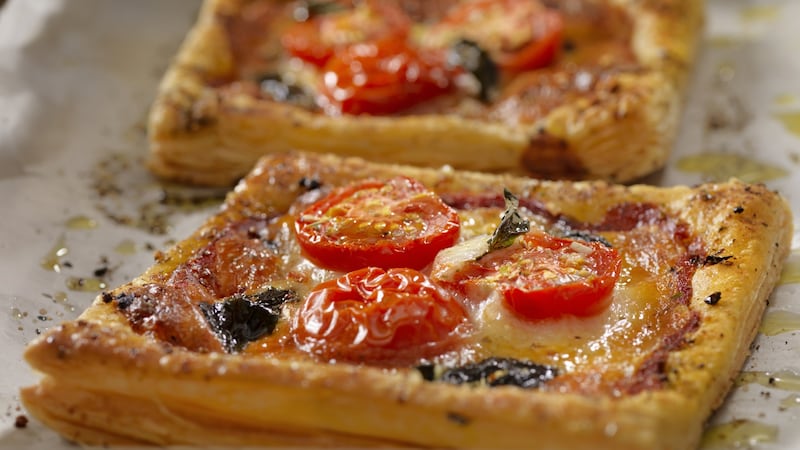
Puff-pastry ‘pizza’
Miguel Barclay
Cut a square of puff pastry, score a 1cm border and scatter over cheese, then tomatoes. Season with salt, pepper and oregano (optional), then bake for about 25 minutes at 180C (160C fan)/350F/gas mark 4.
Jerk and maple cauliflower florets
Denai Moore, Dee's Table
Heat your oven to 200C (180C fan)/375F/gas mark 5. In a big bowl, mix two tablespoons of shop-bought jerk seasoning, two tablespoons of maple syrup and two tablespoons of olive oil. Add in half a cauliflower, broken up into florets. Season with salt and pepper and mix together to coat, taking care not to break the florets.
Grease a baking tray with one tablespoon of olive oil and lay out the florets in a single layer. Cover with a piece of baking paper and put another baking tray on top to weigh down on the cauliflower. Bake for 30 minutes, turning the florets over after 15 minutes, until caramelised and sticky.
Feta-filled potato pops
Sabrina Ghayour, cookbook author
Peel and quarter two medium potatoes, then simmer for 20-25 minutes, until soft. Mash finely, then set aside to cool and refrigerate for a couple of hours. In another bowl, mash up 100g feta with black pepper. Shape the potato mash into ping-pong ball-sized portions and flatten in the palm of your hand to approximately ¾cm thickness. Pile a compressed teaspoon of the feta mixture into the centre of the mash disc and then bring the edges over the filling to seal the ball, filling any cracks with more mash. Lightly dust each ball with flour (you'll need 3-4 tablespoons in total) and repeat.
Heat some oil in a frying pan. When nice and hot, fry the pops until golden brown on both sides, removing with a slotted spoon and draining on kitchen paper when ready. Serve with your favourite sauces or chutneys.
Latkes
Itamar Srulovich and Sarit Packer, Honey & Co
Grate two or three potatoes, place in a colander and sprinkle with salt. Leave in the sink to release some moisture for a few minutes, then squeeze out the rest of the moisture with your hands, place the potato in a bowl and add an egg and a tablespoon or two of self-raising flour (plain flour will do if that is what you have) and more black pepper than you think you need, then mix. If the mix is very loose, add more flour. Heat oil in a pan, about 1cm deep, and drop in little mounds of the mix. Turn when crisp and brown on one side, then take out and place on absorbent paper. Optional extras in the mix include thinly sliced onions or spring onions, anchovies, oregano, feta and smoked paprika.
Jacket potato with kimchi
Judy Joo, Jinjuu
Slit open a baked potato, stuff with some chopped-up kimchi, cover with grated cheese and place under a grill until melted and browning.
Gnocchi
Roberta d'Elia, Pasta Evangelists
Bring a large pot of water to the boil. Peel 1kg potatoes (red if possible) and cook over a low heat until tender, but still firm, taking care that the skin doesn't break (so they don't absorb too much water). This will take 15-20 minutes. Drain, cool down and mash with a fork. Mix in 300g flour (plain, bread or gluten-free will work) and one egg, then knead until a dough forms.
Divide into four portions and shape into long snakes, about 1.5cm in diameter, then cut into 1cm-long pieces. Bring a large pan of salted water to the boil and cook the gnocchi for 2-3 minutes, or until they rise to the surface. Drain and serve with your favourite sauce: butter and sage, gorgonzola and cream with parma ham and walnuts, beef ragu, caprese sauce, basil pesto.
Chickpea and carrot crepes
Anna Jones
Jones puts caraway seeds in her batter and serves the crepes with vegetables, leaves, cheese and eggs. Adapt as you see fit: the basic recipe is a keeper.
Mix together 250g of chickpea flour, 250g of grated carrots and 350ml of milk to obtain a thin, smooth pancake batter. Heat one teaspoon of olive oil in a medium, non-stick frying pan over a medium heat. Add a small ladle of the batter to the pan. Work quickly to swirl it around so the batter covers the base of the pan. Cook for a couple of minutes, then flip over and cook on the other side for another 30 seconds. Repeat with the rest of the batter, adding a little more oil each time. Stack the crepes on a plate with greaseproof paper in between each; keep warm in a low oven.
Tomato with strawberries and basil
Massimiliano Alajmo, Le Calandre
Make a salad of ripe tomatoes and strawberry, sliced, with fresh basil leaves. Season with extra virgin olive oil and flaky salt.
Tomatoes with cottage cheese
Rui Silvestre, Vistas
Blitz 200g of plum tomatoes with a pinch of salt and strain through a sieve. Blitz 50g basil leaves with 100g olive oil, then add to the tomato juice, season to taste and chill in the fridge. Blanche another 300g tomatoes in boiling water for 5-10 seconds then chill in iced water and remove the skin. Blitz 50g cottage cheese with flaky salt, olive oil and ground black pepper until smooth. Serve the skinned tomatoes on a bed of cottage cheese cream, drizzled with the basil oil juice mixture.
Tomato and orange soup
Itamar Srulovich and Sarit Packer, Honey & Co
Peel and slice 10 (yes, 10) cloves of garlic. Slice one orange (skin and all, removing the pips). Place 60ml of olive oil in a pot and gently fry the garlic until fragrant. Add in the orange slices and fry until they start to brown a bit, then add a tin of chopped tomatoes and the same amount of water. Simmer for 20 minutes, then blitz with a stick blender until very smooth. Adjust the seasoning with salt and, if necessary, sugar as well, depending on how sweet the orange is. Delicious served with sourdough toast and goat's cheese; the addition of some thyme or oregano works, too.
Sweet potato flatbreads
Mandy Mazliah, sneakyveg.com
Peel and chop a large sweet potato and steam or boil until soft. Blend until smooth or mash by hand. Place 200g of plain flour in a large mixing bowl and rub in 200g of the sweet potato mash (reserving the rest) with your fingertips, until it resembles breadcrumbs.
Season to taste and add in a little water to make a smooth dough. Divide into six small balls and roll out on a lightly floured surface with a rolling pin dusted with flour. Heat a heavy-bottomed pan over a medium heat and fry the flatbreads one at a time, for two minutes on each side. Serve immediately, or wrap in a clean tea towel or foil to keep soft while you cook the rest.
Chicken thighs with teriyaki sauce
Simon Wood, BBC MasterChef champion
In a hot frying pan, cook 1kg of chicken thighs in vegetable oil until golden all over. Add 220ml of soy sauce and 100g of brown sugar and stir to bring to a boil. Continue stirring until the chicken it cooked and the sauce has reduced; it should evenly coat the chicken, making it sticky.
Chicken thighs with tandoori masala and lime
Romy Gill, Ready Steady Cook chef and cookbook author
Stab six chicken thighs all over with a fork, then place in a bowl with six teaspoons of tandoori masala, the juice of one lime (lemon works, too), six teaspoons of oil and 20ml of cold water. Leave it to marinate for 20-30 minutes and heat an oven to 180C (160C fan)/350F/gas mark 4. Place a baking sheet on a baking tray and, when ready, place the marinated chicken on the sheet and cook for about an hour, or until the juices run clear.
Alternatively, use four teaspoons of harissa (rose harissa, if you can find any), the juice of one lemon and one teaspoon of salt.
Tofu with soy sauce and minced ginger
Anna Thomson
Cut two packs of silken tofu into quarters. Gently slip into a pan of boiling water to heat through. Remove with a slotted spoon and place in four bowls, two pieces per person. Top with soy sauce and minced ginger. Also good topped with toasted sesame seeds and chopped spring onion.
Pasta with lemon and mascarpone
Roberta d'Elia, Pasta Evangelists
Mix the zest of one lemon with 125g mascarpone (ricotta works as well) and season generously. Combine with cooked fusilli to serve. If you happen to have any fresh herbs in the kitchen, such as parsley, basil or thyme, these would work well here.
Pasta with cavolo nero and garlic
Jessica Stanley
Boil chopped cavalo nero and a few whole garlic cloves in salty, oily water for eight minutes. Drain, whizz the leaves and cloves with a stick blender and stir into any cooked pasta, using the pasta cooking water to keep it loose.
Creamy cauliflower liguine
Miguel Barclay
Grab half a cauliflower, pick off some florets, then pan fry with olive oil, salt and pepper. Boil the rest of the cauliflower, drain and blend it with milk (I use oat milk, but any would do), salt and pepper. Mix with cooked pasta, a big glug of olive oil and top with pan fried florets.
Buttered and breadcrumbed whole cauliflower, Warsaw-style
Zuza Zak, cookbook author
After removing the leaves, cook a whole cauliflower in a pan of salted water. In a frying pan, melt a large knob of butter, then brown some breadcrumbs in it. Once the cauliflower is cooked (but still firm) coat it in the breadcrumbs and serve – dill potatoes make a nice accompaniment.
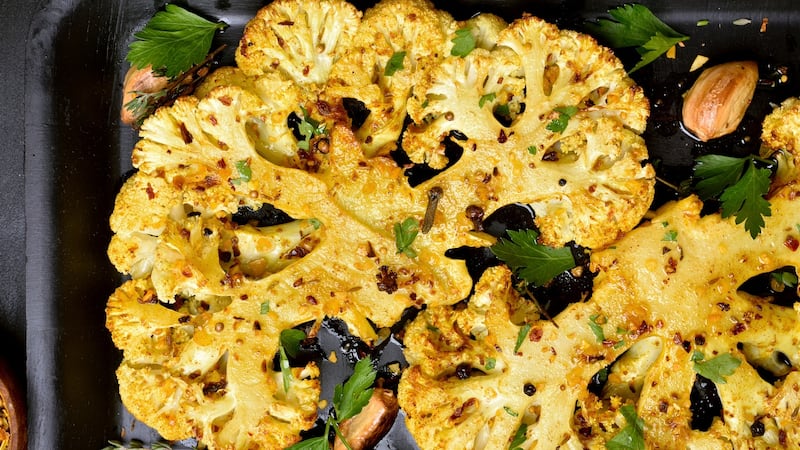
Roasted whole cauliflower, with yeast butter and smoked trout
Keelan Higgs, Variety Jones
Add a whole cauliflower to a pot of heavily salted boiling water, and cook for two minutes, then remove and leave to cool for 30 minutes. Heat the oven to 190C (170C fan)/375F/gas mark 5. Heat some oil in a large ovenproof pan over a high heat and add the whole cauliflower, root side down. Drizzle with 2-3 tablespoons of olive oil. Crumble 30g of fresh yeast on to a baking tray and bake for eight minutes, until dark brown and caramelised.
Remove the cauliflower from the oven and put back on the stove over a medium-high heat. Add 100g of butter and, once foaming, baste over the top of the cauliflower with a large spoon 15-20 times, then turn the cauliflower upside-down and put the pan back in the oven for five minutes.
Remove the cauliflower from the oven again, stir the yeast into the butter until semi-dissolved and baste the cauliflower 20-25 times, then return to the oven for a final five minutes before removing from the oven, basting another 20-odd times. Remove from the pan and on to a chopping board. Reserve the yeast butter. Chop into four evenly sized pieces and serve topped with 2-3 large spoonfuls of the yeast butter and a large slice of smoked trout.
Aubergine with miso and honey
Anna Thomson
Cut two aubergines in half lengthways. Lightly score the flesh with a criss-cross pattern.
In a wide pan, heat some oil over a medium heat and lay the aubergines to fry on each side for a few minutes. Turn down the heat, cover with a lid and cook until soft, turning now and again. Place flesh side up on a serving plate.
In a small bowl, mix 2-3 tablespoons of miso with two teaspoons of honey, loosen with a little hot water, then spread over the aubergine. This is delicious topped with chopped spring onion or sesame seeds and served with rice.
Asparagus with pecorino and mint
Tom Anglesea, The Laughing Heart
Peel and trim a bunch of asparagus. Shave into ribbons with a peeler, then wash in cold water and drain. Shave 70g of pecorino into shards and toss with the asparagus and the picked leaves of half a bunch of fresh mint, roughly chopped. Dress with olive oil and season with salt and pepper.
Green beans with walnuts and shallots
Alexandra Stacey
Trim a pack of green beans and boil in water for eight minutes. Drain, season with salt and pepper and set aside to cool. In a shallow pan, toast a small handful of walnuts over a medium heat for 3-4 minutes, turning constantly so that they don't burn. Combine the beans and walnuts with half a shallot, finely sliced and chopped, and serve, drizzled with lots of olive oil.
Carrot with vinegar and honey
Olia Hercules, cookbook author
Roughly grate or julienne a handful of carrots. Dress with a mixture of vinegar, honey and salt that is perfectly sweet, sour and salty. Leave for at least an hour, and up to a month. Use as fresh salad or as a pickle in some pitta bread with cheese or chicken.
Labneh, aubergine and harissa
Lucy Carr Ellison and Jemima Jones, Tart London
Line a sieve with a clean dishcloth or cheese cloth. Spoon in 500g yogurt, tie up the cloth and leave to hang above a bowl for 2-24 hours. Heat the oven to 200C (180C fan)/400F/gas mark 6. Place the aubergine on a tray, drizzle with olive oil and season with salt and pepper and roast for about 20 minutes, until golden all over. Mix four tablespoons of olive oil with two tablespoons of harissa, drizzle over the aubergine and toss. Spoon the labneh out of the cloth, spread on a plate and top with the aubergine mix. Finish with a good drizzle of olive oil.
Sweetcorn salsa
Jessica Stanley
Drain a can of sweetcorn. Sizzle olive oil in a hot pan and fry the corn. When cool, serve with chilli flakes or smoked paprika, oil, salt and lime.
Roasted fennel, cherry tomatoes and spring onion
Luisa Weiss, cookbook author
Heat the oven to 180C/160C fan/350F/gas mark 4. Trim one large bulb of fennel and slice in half, lengthways, then cut out the core and discard. Cut each half in half again. Place the quarters in a baking dish along with two handfuls of cherry tomatoes and four spring onions, trimmed and cut into two-inch pieces.
Season with salt and pepper to taste, and drizzle with 3-4 tablespoons of olive oil. Toss to coat. Bake for 30-35 minutes, shaking the dish once halfway through. Then turn off the oven and let the dish cool with the oven door closed for another half hour (or for as long as you can). Serve with lots of crusty bread, if possible.
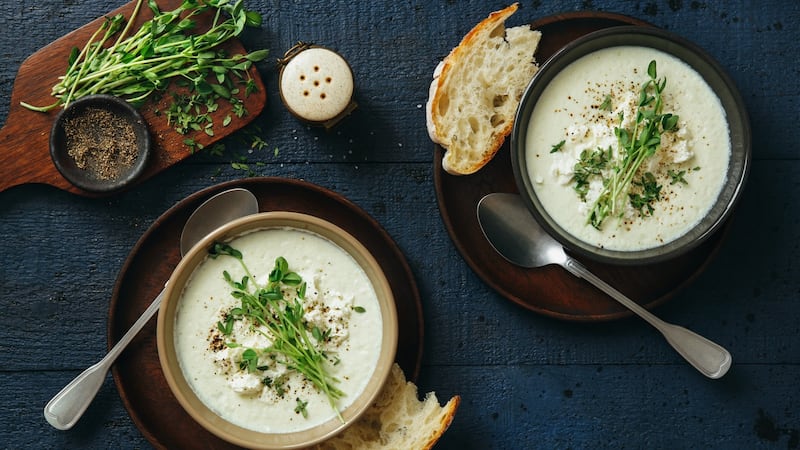
Broccoli and blue cheese soup
Jeremy Chan, Ikoyi
Thinly slice 400g of broccoli. Roast half and keep the rest raw. Add all of it to a blender with 300ml of chicken stock and 150g of blue cheese. Blitz for 10 minutes, until smooth. To serve, heat through and season well.
Polenta with sauteed mushrooms and toasted cashews
Anna Thomson
Bring 400ml of water to the boil in a large saucepan. Pour in 100g of polenta, whisking continuously as it thickens. Season well, stir in a knob of butter and cook slowly until it comes away cleanly from the pan. Toast a handful of cashews under the grill or in a dry frying pan until golden. Top the polenta with more butter, mushrooms sauteed in a little olive oil season well and the toasted cashews.
Bulgur wheat pilaf
Sabrina Ghayour, cookbook author
Heat a saucepan (for which you have a lid) over a medium heat and soften one finely chopped onion until soft and translucent. Add 200g of bulgar wheat and stir to coat. Then add two tablespoons of tomato puree, a very generous amount of salt and pepper and a generous knob of butter, if you like. Break down the puree and ensure it coats the bulgar wheat evenly. Pour 450ml of cold water over the mixture, stir well and cover with a lid. Reduce to a gentle medium heat and cook for 20-25 minutes or until the liquid is fully absorbed. Use a fork to fluff up the grains and serve.
Rice with green tea and salted salmon (ochazuke)
Dale Berning Sawa
Cook some short-grain Japanese rice. Season a salmon fillet with salt and leave for 10 minutes, then bake until slightly crispy. Dish up a bowlful of rice, top with chunks of salmon and pour hot green tea over until it covers half the rice. Serve as is, or add anything else you like: pickles, salted umeboshi plum, soy sauce, sesame seeds, bitter green leaves, chopped up toasted nori seaweed.
Sweet coconut rice
Jeremy Chan, Ikoyi
Toast 380g of jasmine rice in a pot with some oil until all the grains are well coated. In a saucepan, bring a 400g can of coconut milk to a simmer, season well and melt in 35g of honey. Add the warm coconut milk to the pot with the rice and quickly bring to the boil. Stir once to ensure no rice sticks to the base, then turn to a simmer and place a lid on the pan. Cook for 13 minutes and then turn off the heat and rest for five minutes, without opening the lid, to steam. After five minutes, open the lid to fluff up the rice before serving.
Yogurt rice
Yotam Ottolenghi makes this to serve with spicy chana dal and wilted greens. I’d happily have it with sour salty pickles, toasted nuts or just as it is.
Put 200g of basmati rice, two tablespoons of oil, 200ml of hot water and 1-2 teaspoons of salt in a large saute pan on a medium-high heat. Bring to a simmer, stirring often, until most of the water has been absorbed, then repeat, adding 200ml of hot water at a time and stirring often, until you have used up 1.2 litres of the water and the rice resembles a loose, creamy porridge – this will take about 20 minutes.
Lightly crush the rice grains with the back of a spoon then turn down the heat to medium-low. Whisk one egg yolk with 200g of Greek yogurt and 50ml of hot water until smooth, then stir into the rice and cook, stirring often, for about seven minutes, until the mixture has thickened slightly, but is still a loose porridge.
Yellow split pea stew
Anna Jones serves this with yogurt, olives, fresh mint and cucumber. Salted well, though, with a good amount of lemon juice, it’s a treat all on its own. Soak 450g of split peas in cold water overnight. This isn’t essential, but will halve the cooking time. Drain the peas and place in a large saucepan and cover with cold water. Bring to a rapid boil and let cook for 10 minutes, then reduce the heat and simmer for a further 20–30 minutes, or until tender. Drain, season and set aside. Put a large pot on a medium heat.
Add the oil, two onions, peeled and finely chopped, and ½ teaspoon of salt. Cook for five minutes or so, until soft. Add the cooked split peas and 350ml of cold water. Bring to a simmer for a few minutes, then remove from the heat. Ladle half the soup into a bowl and set aside. Use a stick blender to puree the rest of the soup in the pan. Stir the chunky soup back into the puree for a soup that is nicely textured. Thin the soup with more water (or stock) as needed before serving, seasoned with some flaky salt and a good squeeze of lemon.
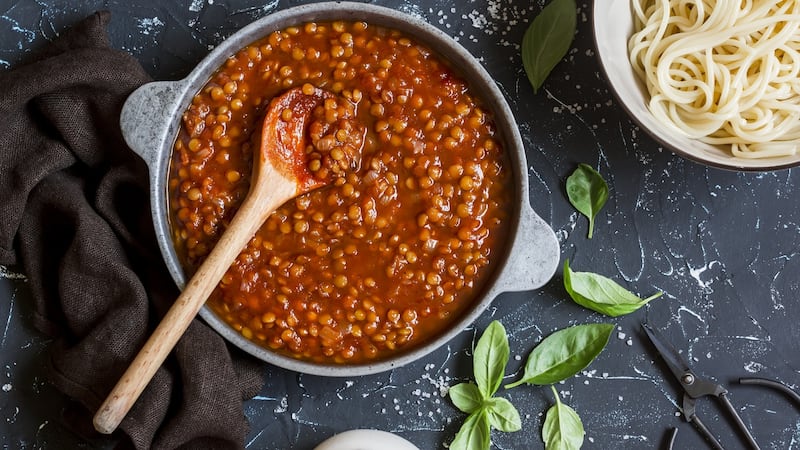
Lentil bolognese
Jessica Stanley
Use one tin of whole tomatoes per person for this. Start by draining the juice fromthe tomatoes and reserve for a future recipe. Rinse the whole tomatoes, taking care to keep their shape. Pat dry, cover in olive oil, sprinkle with salt. Cook for two hours at 140C/120C fan/275F/gas mark 1, or for an hour and a half at 160C/. Crush the tomatoes with a fork or potato masher. Add a tin per person of (drained and rinsed) lentils, heat through and serve with spaghetti.
Fermented rye soup with garlic (Zurek)
Zuza Zak, cookbook author
Put four tablespoons of rye flour in a large jar with two crushed cloves of garlic, and cover with 400ml of warm (pre-boiled) water. Cover with a tea towel and allow to stand in your kitchen for five days, stirring daily. After that, keep it in your fridge. To make the soup, add to a litre of vegetable stock and heat through. Top with crispy bits of garlic or garlic croutons to serve. Optional extra toppings include a lick of cream and can be served with a hard-boiled egg, fried bacon bits or whatever you have available.
Smoked mackerel with beetroot and horseradish
Anna Thomson
Peel and slice the beetroot into chunky slices. Drizzle with olive oil and season, bake in the oven until soft and slightly caramelised. Fry mackerel fillets on both sides until the skin is crisp (ensure your kitchen is well ventilated!) Serve on the roasted beetroot with a generous dollop of horseradish or tartare sauce (mayonnaise or plain yogurt spiked with lemon and garlic works, too).
Chicken stock egg pudding (chawanmushi)
Ollie Templeton, Carousel
Whisk four eggs with 500ml of chicken stock and 1-2 tablespoons of soy sauce, then sieve and pour into four bowls. Cover with tin foil and steam in a steamer (or a large lidded pot with boiling water going halfway up the sides of the bowls) for 30 minutes, until set – there should be a nice wobble in the middle. Allow to cool before serving.
Halloumi and apricot jam sandwich
Georgina Hayden, cookbook author
Heat a griddle pan – or your oven grill – and grill three slices of halloumi (about 1½cm thick) for a couple of minutes on both sides, until golden and soft, but not rubbery. Meanwhile, lightly toast two slices of bread (good quality white is best), butter and top with a good layer of apricot jam. When the halloumi is ready, put it on the jam, close the sandwich and gently press together. Serve immediately, while the cheese is warm.
Lemon posset
Alex Head, Social Pantry
Slowly heat 400ml of cream and whisk in 100g caster sugar. Bring to a gentle simmer for three minutes then remove from the heat and whisk in the juice and grated zest of one large lemon. Divide between four ramekins and refrigerate until set and chilled.
Nut butter cookies
Simon Wood, MasterChef champion
Heat oven to 180C/160C fan/350F/gas mark 4. In a large bowl or food processor, mix 240g of peanut butter, 100g of sugar and one egg into a dough. Take one tablespoonful at a time and roll it into a ball. Place each on a nonstick baking tray, flatten slightly with a fork and bake for 8-10 minutes or until the bottom of the cookies are golden. Remove from baking sheet and cool for 20 minutes before eating.
Foolproof meringues
Natasha Collins, cookbook author
Heat the oven to 120C/100C fan/250 F/gas mark 1/2. Line two large baking trays with baking paper. Whisk together six egg whites and ¾ teaspoon of cream of tartar until stiff peaks form – this should only take a minute or so. Keep beating and gradually add 310g sugar, one tbsp at a time. Beat until the sugar has dissolved – if you rub a little of the mixture between your thumb and fingers it should feel smooth. Take a heaped tablespoon of the mixture and, with another spoon, drop on to the baking tray. Repeat with the rest of the mixture, then place the baking trays in the oven and bake for 2½ hours. If you see the meringues starting to turn golden brown take them out. Leave to cool on the trays.
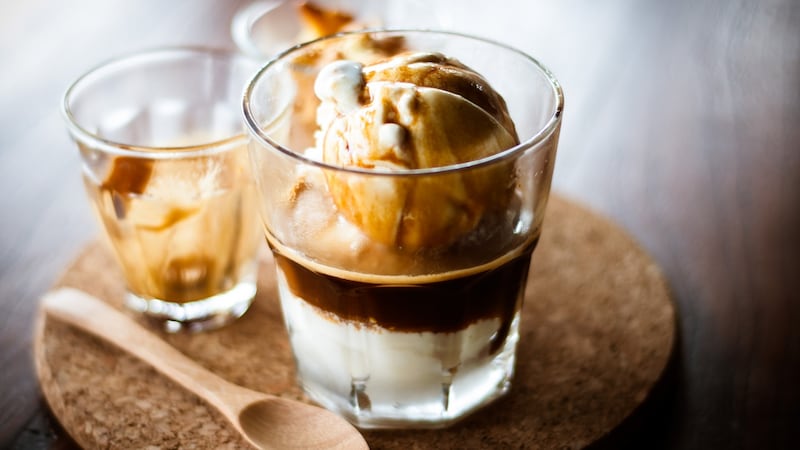
Crunchie ‘affogato’
John Quilter
Crush a Crunchie bar unopened in its wrapping with a rolling pin. Add two scoops of ice-cream to each serving bowl, pour over hot coffee and sprinkle with the crushed Crunchie pieces.
Pear and chocolate puff-pastry ‘strudel’
Cori Pim-Keirle
Heat your oven to 220C/200C fan/425F/gas mark 7 and line a baking tray with baking parchment. Peel, core and chop 5-6 pears into bite-size chunks. Pat dry and, in a mixing bowl, combine with 75g dark chocolate, roughly chopped. Unroll the pastry and, with the long edge facing you, pile the filling along the lower half of it. Moisten the edges with a little water and fold over the top. Press down on the edges with a fork to seal well. Make several cuts across the top.
(Normally I’d give the whole thing a final glaze with an milk/egg wash and sprinkle with a little demerara sugar for a crunchy finish, but it’ll work just as well without). Bake for 30-35 minutes, until puffed up – cover with a piece of foil if it browns too quickly on the edges.
Berry ‘ice-cream’
Claire Thomson, cookbook author
Put 400g of frozen berries (or any frozen soft fruit, such as kiwi, mango, banana), two tablespoons of runny honey (or more to taste) and 200g of full-fat Greek yogurt (or creme fraiche) in a blender and puree until smooth. Serve immediately.
Almond nougat
Ciccio Sultano, Duomo
In a saucepan, melt 300g of granulated sugar and 100g of honey. In another pan, toast 100g of almonds. Once the almonds are golden, add to the sugar and caramelise for about 5-10 minutes. Remove from the heat and spread across an oiled chopping board, levelling the surface. With a long, sharp knife, cut into cubes, then leave to cool. Preserve in a glass jar.
Roasted rhubarb with vanilla
Luisa Weiss, cookbook author
Heat the oven to 180C/160c fan/350F/gas mark 4. Cut 500g of rhubarb into 2-3-inch chunks and place in a baking dish. Slit one vanilla pod lengthways and scrape the seeds on to the rhubarb (or use one teaspoon of vanilla essence). Add 50g of sugar and toss gently to coat (push the bean under the rhubarb if using). Bake for 15-20 minutes, then set aside to cool (dry the bean, if used, and grind with more sugar for future use as vanilla sugar). Serve with cream or yogurt, if you have any.
Apple ‘crumble’
Jessica Stanley
Grate an apple and sprinkle with granola. Serve with yogurt.
Quick crumble topping
Henrietta Inman, cookbook author
Heat the oven to 180C/160C fan/350F/gas mark 4 and line a tray with parchment paper. Mix 300g of any flour (wholemeal, white, spelt, rye, gluten-free, ground nuts, desiccated coconut, oats, buckwheat …) with 150g-200g of unsalted butter and 80-100g of whatever sweetness you have (any sugar, honey, maple syrup …) in a free-standing mixer or with your fingertips, until it resembles breadcrumbs. Spread over the tray and bake for 10 minutes.
Remove from the oven, chop up a little and return to the oven and bake for a further 10 minutes or until golden. Serve as is, or with fresh fruit and yogurt, compote and cream, creme fraiche, honey and orange zest, ice cream and chocolate sauce. (You can also add anything from lemon or orange zest, vanilla, a pinch of salt, a handful of nuts or seeds, a few tsp cocoa powder, or whatever you think might work to the crumble mix).
Berries with chocolate mousse
Cori Pim-Keirle
Arrange 150g of pitted cherries, raspberries or strawberries in the bottom of of serving dishes. Melt 100g of dark chocolate in a bain marie, then set aside to cool. Pour 170ml of aquafaba (the liquid drained from a can of chickpeas) into the bowl of a stand mixer and whip on full speed until firm peaks form (This will take quite a lot longer than it would with egg whites.) Stir a large dollop of this into the cooled, melted chocolate to lighten it before very carefully folding in the rest. Be as gentle as possible to minimise any loss of air. Divide the mousse evenly over the fruit and chill for several hours to set. – Guardian














